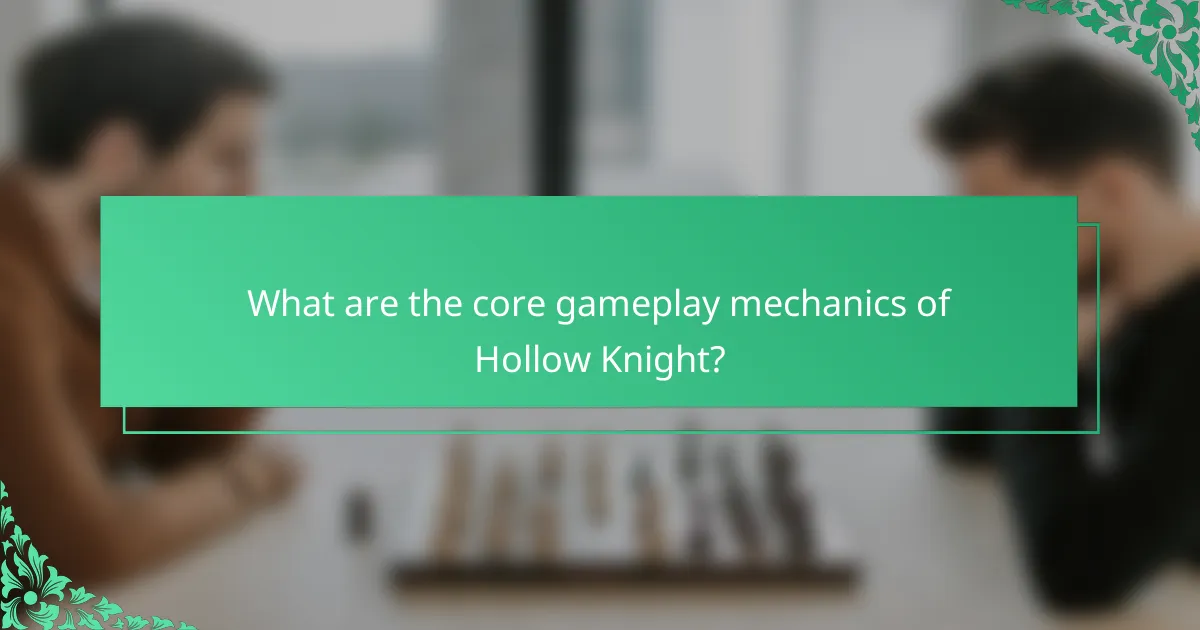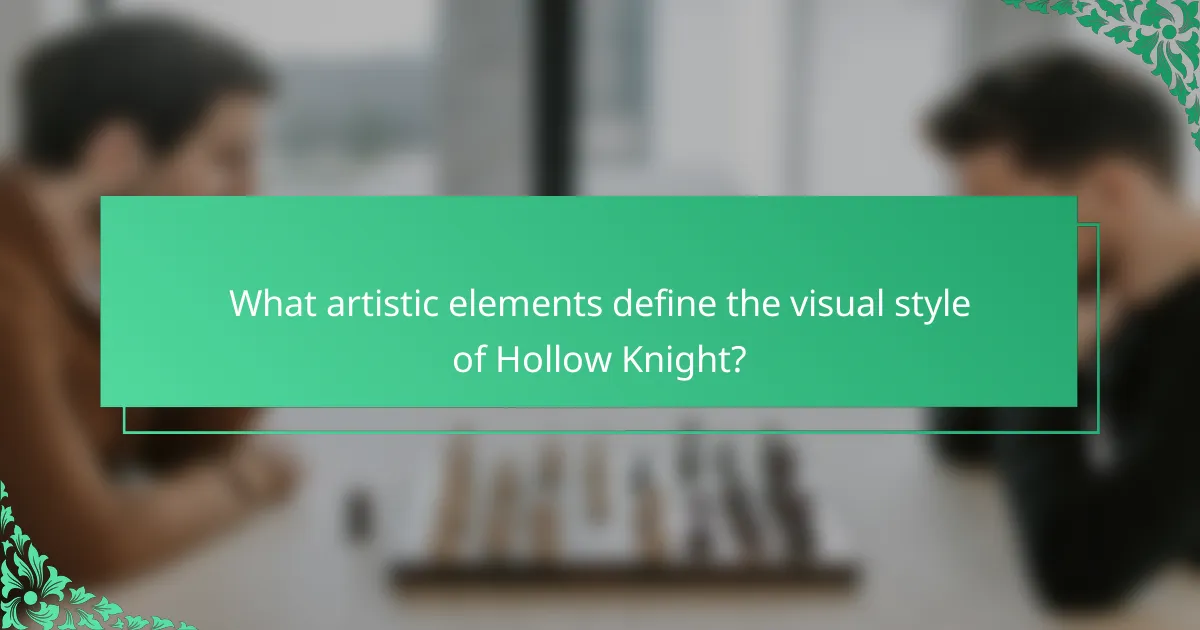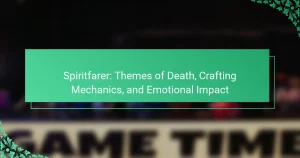Hollow Knight offers a rich gaming experience with its intricate gameplay mechanics, unique art style, and deep storytelling elements. Players explore a vast interconnected world, engage in skill-based combat, and uncover immersive narratives. The game’s hand-drawn visuals enhance its atmospheric environments, while environmental storytelling adds depth to character interactions. Together, these elements create a compelling adventure that challenges players and invites exploration.

What are the core gameplay mechanics of Hollow Knight?
Hollow Knight features core gameplay mechanics that include exploration, combat, and platforming. Players navigate a vast interconnected world, engaging in battles with diverse enemies and bosses. The game emphasizes skill-based movement, requiring precise jumps and dashes. Unique attributes include a charm system that allows customization of abilities, enhancing gameplay variety. Additionally, the game incorporates a Metroidvania structure, encouraging backtracking to uncover secrets and new abilities.
How do combat mechanics enhance player engagement?
Combat mechanics in Hollow Knight significantly enhance player engagement by providing challenging encounters and rewarding skill mastery. These mechanics create a dynamic atmosphere where players must adapt their strategies, fostering a sense of accomplishment. The game’s fluid combat system encourages exploration and experimentation, allowing players to discover unique abilities and combinations. As a result, the combination of challenging enemies and responsive controls deepens the overall gameplay experience, keeping players invested in their journey through the beautifully crafted world.
What role does exploration play in the game experience?
Exploration is crucial in “Hollow Knight,” enhancing the game experience by fostering discovery and immersion. Players navigate a beautifully crafted world filled with hidden secrets, lore, and challenging enemies. This encourages curiosity and engagement, as players uncover new abilities and areas that enrich gameplay. The interconnected map design rewards exploration, allowing players to revisit locations with new skills, deepening their understanding of the game’s narrative and mechanics. Overall, exploration transforms gameplay into a dynamic journey, making each player’s experience unique and personal.
How does the progression system impact gameplay?
The progression system significantly enhances gameplay in Hollow Knight by providing players with a sense of growth and achievement. Players unlock new abilities and upgrades that allow for deeper exploration and combat strategies. This system encourages revisiting previous areas, revealing hidden secrets and enhancing the overall experience. Unique attributes, such as the ability to acquire charms that modify gameplay, further enrich player engagement. As players progress, they face increasingly challenging enemies, making skill development essential for success.

What artistic elements define the visual style of Hollow Knight?
Hollow Knight’s visual style is defined by its hand-drawn art, atmospheric environments, and intricate character designs. The game features a dark, moody aesthetic that combines gothic elements with a whimsical charm. Unique attributes include the fluid animations and detailed backgrounds that enhance the immersive experience. The use of a limited color palette creates a cohesive yet diverse world, making each area distinct while maintaining a unified artistic vision. Rarely, the game employs stark contrasts between light and shadow to emphasize emotional storytelling.
How does the art style contribute to the game’s atmosphere?
The art style of Hollow Knight significantly enhances the game’s atmosphere by creating an immersive, haunting environment. The hand-drawn visuals evoke a sense of depth and intricacy, contributing to the overall mood. The use of dark, muted colors combined with detailed backgrounds fosters a feeling of isolation and exploration. Unique character designs and fluid animations add to the emotional weight of the narrative, making encounters feel impactful. This visual approach, paired with the game’s sound design, creates a cohesive experience that resonates with players, drawing them deeper into the world of Hallownest.
What influences can be seen in the character design?
Character design in Hollow Knight is influenced by themes of nature, decay, and the interplay between light and darkness. The game’s art style reflects its melancholic atmosphere, with intricate details showcasing the unique attributes of each character. The designs often embody root attributes of vulnerability and resilience, emphasizing the struggles within the game’s narrative. Additionally, rare traits, such as the blend of insect-like features with human characteristics, enhance the distinctiveness of the characters, making them memorable and integral to the storytelling elements.
How does the environment design shape player immersion?
The environment design in “Hollow Knight” significantly enhances player immersion through intricate visuals and atmospheric sound. The interconnected world invites exploration, fostering a sense of discovery. Unique attributes like the hand-drawn art style create a visually captivating experience, while ambient sounds deepen emotional engagement. Environments reflect the game’s lore, enriching storytelling and player connection. Each area features distinct themes, encouraging players to immerse themselves in the narrative and gameplay mechanics.

How is storytelling integrated into the gameplay of Hollow Knight?
Storytelling in Hollow Knight is woven into gameplay through environmental narratives and character interactions. Players uncover the lore of Hallownest by exploring its intricately designed world, where each area tells a story through visual cues and subtle hints.
Characters provide rich backstories and emotional depth, enhancing player engagement. For example, encounters with NPCs reveal personal tales that connect to the overarching narrative. The game’s art style complements storytelling, using atmospheric visuals to reflect the history and mood of the environment.
Additionally, gameplay mechanics, such as the use of relics and artifacts, serve as storytelling devices. Each item often has a unique description that adds layers to the lore. This integration of storytelling makes Hollow Knight not just a game, but a profound experience that invites players to delve deeper into its mysterious world.
What narrative techniques are employed to convey the story?
Hollow Knight employs various narrative techniques to effectively convey its story. These include environmental storytelling, where the game’s world design reveals lore through visual cues and background details. Dialogue with NPCs provides context and depth, enriching character relationships. The use of minimalistic storytelling invites players to piece together the narrative, creating an engaging experience. Flashbacks and dream sequences further enhance the emotional impact, allowing players to explore the protagonist’s past. Each technique contributes to a rich, immersive narrative that complements the game’s challenging gameplay and artistic style.
How does lore enhance the gaming experience?
Lore significantly enhances the gaming experience in Hollow Knight by deepening immersion and emotional engagement. The intricate backstory and rich world-building create a sense of history that players can explore. Players uncover lore through environmental storytelling, NPC dialogues, and item descriptions, which enriches gameplay. This narrative depth fosters a connection to the game’s characters and their struggles, making victories feel more impactful. Furthermore, the lore invites players to piece together the story, encouraging exploration and critical thinking.
What role do characters play in the overall narrative?
Characters in “Hollow Knight” are essential to the narrative, providing depth and emotional resonance. Each character embodies unique traits that enhance the story’s themes, such as isolation, sacrifice, and perseverance. The protagonist, the Knight, symbolizes resilience amidst darkness, while supporting characters like Hornet and the Pale King reveal the lore of Hallownest through their interactions and backstories. These relationships create a rich tapestry that engages players, making the world feel alive and interconnected. Ultimately, characters drive the narrative forward, influencing the player’s journey through their motivations and conflicts.

What unique attributes set Hollow Knight apart from other indie games?
Hollow Knight stands out from other indie games due to its intricate gameplay mechanics, unique art style, and deep storytelling elements. The game features a seamless interconnected world that encourages exploration and discovery. Its hand-drawn visuals create a distinct aesthetic that enhances the atmosphere. The narrative unfolds through environmental storytelling and subtle lore, engaging players in a rich, immersive experience. Additionally, the challenging combat mechanics and diverse abilities provide a unique gameplay depth that differentiates it from typical indie titles.
How does the game’s difficulty curve differentiate it from competitors?
Hollow Knight’s difficulty curve sets it apart by offering a gradual increase in challenge that enhances player skill. Players encounter progressively tougher enemies and intricate platforming, which encourages mastery of mechanics. This design contrasts with competitors that may present spikes in difficulty, leading to frustration. The game’s unique attribute lies in its balanced pacing, allowing for exploration and learning without overwhelming players. As a result, Hollow Knight fosters a rewarding experience that keeps players engaged while challenging them effectively.
What innovative features contribute to its unique gameplay experience?
Hollow Knight features innovative mechanics that create a unique gameplay experience. The interconnected world design encourages exploration and discovery. Combat mechanics, including precise controls and varied enemy patterns, enhance engagement. The use of charm customization allows players to tailor abilities, adding depth to strategy. Additionally, the atmospheric art style and haunting soundtrack immerse players in the game’s emotional narrative.

What are the common challenges players face in Hollow Knight?
Players in Hollow Knight commonly face challenges related to difficult combat, intricate platforming, and navigating a vast interconnected world. Boss battles require precise timing and strategy. Environmental hazards, such as spikes and enemies, add to the difficulty. Limited resources, like health and soul, create tension during exploration. Players often struggle with learning enemy patterns and mastering abilities. These challenges enhance the game’s depth and engagement.
How can players overcome difficult boss encounters?
Players can overcome difficult boss encounters in Hollow Knight by mastering the game’s mechanics and patterns. Focus on learning attack patterns, timing dodges, and utilizing the right charms to enhance abilities.
Developing spatial awareness is crucial; players should position themselves strategically to avoid damage while delivering hits. Experiment with different charms to find combinations that suit playstyle and boss weaknesses.
Utilizing the environment can provide advantages; players can use terrain to evade attacks or heal during encounters. Patience and practice are essential; repeated attempts will improve understanding of bosses and refine strategies.
Lastly, consider watching gameplay videos or guides for tips and techniques from experienced players to gain new insights into effective strategies.
What strategies help in navigating complex environments?
Effective strategies for navigating complex environments in Hollow Knight include mastering combat mechanics, exploring the interconnected world, and utilizing map upgrades. Combat mechanics require players to learn enemy patterns and adapt their strategies. Exploration is essential for uncovering secrets and hidden pathways. Map upgrades enhance navigation and reveal important locations, aiding in overall progress. These elements combine to create a rich gameplay experience that encourages skill development and strategic thinking.

What are the best practices for new players in Hollow Knight?
New players in Hollow Knight should focus on exploration, mastering movement, and understanding enemy patterns. Prioritize upgrading your abilities and charms to enhance combat effectiveness. Engage with NPCs to gain insights and lore that enrich the experience. Learning to dodge and parry effectively is crucial for survival. Take time to familiarize yourself with the map, as it reveals hidden areas and secrets that can aid your journey.
Which upgrades should be prioritized for effective gameplay?
Prioritize upgrades that enhance mobility and combat effectiveness for effective gameplay. Key upgrades include the Dash ability, which improves evasion, and the Double Jump, increasing vertical movement. Focus on obtaining the Nail upgrades to enhance attack power, which is crucial for defeating tougher enemies. Lastly, consider Charm upgrades that complement your playstyle, such as those enhancing health or damage output.
What tips can enhance exploration and combat efficiency?
To enhance exploration and combat efficiency in Hollow Knight, players should focus on mastering movement mechanics and utilizing the right abilities. Prioritize upgrades that improve mobility, such as the Dash and Wall Jump, which allow for swift navigation and evasion.
Utilize charms strategically; for instance, the Quick Focus charm accelerates healing, while the Sprintmaster charm boosts movement speed. Combining these can significantly improve combat responsiveness.
Explore the environment thoroughly to discover hidden areas and collect resources, enhancing your character’s abilities. Engage with NPCs for lore and potential rewards that can aid in your journey.
Finally, practice enemy patterns to anticipate attacks, allowing for better dodging and countering, which is crucial for surviving tougher encounters.


